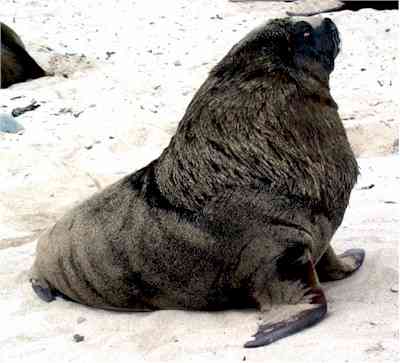Drawing Logical Conclusions
Sea Lion SavvyOur knowledge is a little island in a great ocean of nonknowledge. - Isaac Bashevis Singer by Betsy Mason
"Rio can get antsy when she’s about to do her experiment," remarks Shannon Spillman, a trainer observing from inside the lab. A little nervous, she takes a deep breath, puts on a microphone headset, studies her notes for a moment, places her hands on a music keyboard, and checks Rio’s activity on a video screen. She looks like an air-traffic controller. "It’s a lot to keep track of," she says. "Ready?" Spillman asks the student volunteers outside at the pool. "OK, let’s go." And the show begins.
This mysterious experiment is actually a demonstration of Rio’s ability to think. She has surprised researchers with feats of logic no animals other than humans have accomplished in the laboratory. Rio and her cohort, Rocky, have demonstrated an ability to draw logical conclusions that was previously thought to require spoken language. Now it seems language requires logic, rather than the opposite. This singularly important research comes from the lab of Ronald Schusterman at the University of California, Santa Cruz, who has spent years painstakingly training the sea lions. Schusterman believes these abilities may have evolved to help animals solve complex social problems in the wild, like the recognition of friends and foes, by using many different cues such as sight, smell, and sound. "It really expands our notion of how an animal perceives its world," he said. Schusterman’s interest in the animal mind began in 1960 at Yerkes Laboratories of Primate Biology in Orange Park, Florida, where he investigated the cognitive and social behavior of chimpanzees, gibbons, and monkeys. In 1963 he moved to the Stanford Research Institute to establish the first laboratory in North America devoted to the behavior and physiology of seals and sea lions. Schusterman and his sea lions spent a few years at California State University at Hayward before they moved to the University of California’s Long Marine Laboratory in Santa Cruz, where they remain today. "Whatever place would allow me to bring my sea lions, that’s where I went," he said. Rocky and Rio are international stars in the scientific community and in the public eye as well. They have been featured in Time magazine and USA Today, and have appeared on a PBS television show called "Animal Einsteins." Schusterman’s prize pupil, Rio, was born in captivity 15 years ago and raised by a human surrogate mother. She is an eager, playful student and seems to enjoy her role in the research. Her motivation and focus make her a perfect subject. Rio may be the star of the show, but Rocky is the real veteran. Abandoned in the wild as a pup, she has been with Schusterman since her rescue at age one. Rocky’s 25 years put her well beyond the average 16-year life span of a wild California sea lion. Despite cataracts that hamper her ability to perform in experiments, she continues to be a willing participant. At 150 pounds, she is smaller than the average female sea lion, but her contribution to our understanding of the animal mind carries a lot of weight. Inspired by research with bottlenose dolphins at the University of Hawaii, Schusterman taught Rocky sign language at age 10. She learned to perform complex tasks involving multiple signs, such as touching a small white ball with her flipper or bringing a big black cone to a small black ball. Individual dolphins and primates had already become proficient with sign language, but Rocky is all the more noteworthy for clearing the same mental hurdle with a smaller brain. Her accomplishment led Schusterman to speculate that he was dealing with a very basic learning process that could be at the root of many complex behaviours. So he set out to reveal the underlying mechanism.
For Rio, the answer is a convincing yes. She knew the answer immediately, and she responded correctly the first time she was given the same type of choice with every group of symbols. "It was almost hard to believe when we got the results," Schusterman said of Rio’s first demonstration. This intellectual leap proved that Rio could form logical connections in her mind that weren’t directly trained. Before Rio’s success, many scientists believed that the ability to make these connections, known as "equivalence," was a uniquely human characteristic, impossible without spoken language. Instead, it may be an essential building block for language. "Dr Schusterman is the only one that has, I think, unequivocally shown equivalence in nonhuman subjects," said Murray Sidman of the New England Center for Children in Southboro, Massachusetts. "Of all the work with nonhumans, it most resembles what we see with human beings." Research with human babies has shown that these logical abilities are present before the ability to speak. Similar research with retarded children also has revealed logical thinking in the absence of speech. Sidman was the first researcher to show this ability in a nonspeaking human. He is considered the father of the equivalence theory often referred to as "Sidman equivalence." His 1971 study used equivalence to explain the development of reading comprehension in a severely retarded teenage boy. In this seminal experiment, the three "symbols" to be matched were a picture, a printed word, and a spoken word. The boy was taught to respond to the spoken word "chair" by selecting a picture of a chair or the printed word, C-H-A-I-R. The boy was then able to close the logical loop, responding to the written word by choosing the picture and vice-versa. In order to have language, humans need to be able to assign meanings to words. One theory is that a set of equivalence associations between the verbal and visual representations of an object is at the core of our ability to speak. Human babies start making these connections before they are able to verbalise them. Once they begin speaking, it is easy to watch the set of associations grow as they connect the word "mama" with the sight of their mothers, or the word "cookie" with their favorite snack. "There’s nothing magic about language," said William Dube of the EK Shriver Center for Mental Retardation in Waltham, Massachusetts, who has also done equivalence work with humans. "One of the things that underlies our language is this network of symbolic relationships. You don’t learn every relationship directly, but you’re able to behave as though all of them had been directly trained." Schusterman believes Rio has shown us that equivalence might not be just a step in human language development, but also a stage in the evolution of language. "I believe that equivalence is a precursor to language in an evolutionary sense," Schusterman said. Sea lions haven’t evolved their own language. But they may have laid the foundation, offering a glimpse into the mysterious evolution of human language. However, a few researchers who work with humans question the importance of Rio’s demonstration. Steven Hayes, a psychologist at the University of Nevada at Reno, is skeptical about the modifications Schusterman made to the methods used with humans. Unlike Hayes and some of his colleagues, Schusterman uses multiple examples of the same problem to help the sea lions understand what is being asked of them. He also uses fish rewards as reinforcement. Hayes feels the rewards and repetition are clouding the results. "It’s very tricky to know if it is functionally the same thing as we see in humans. I want to see it done exactly the way we get it in 18-month-old babies," he said. Schusterman stands by his technique. "As in any kind of experiment with animals in the laboratory where you are interested in an animal answering a question, you have to make sure the animal understands the nature of the question," he said. "With humans, you can speak to them and give them instructions. With animals, you can only provide lots of examples. Once you provide those examples, then you can set up your testing procedure. That’s what we’ve done." Excited by their success, Schusterman and his graduate students continue to test the limits of the sea lion psyche. Colleen Kastak, a graduate student who has been working with Schusterman for nearly 10 years, has been involved with the equivalence work almost from the start. During that time, she has tirelessly worked with Rocky and Rio to expand on Rio’s initial demonstration of equivalence. Her most recent work represents a surprising and important step: proving that the sea lions can organise symbols into functional categories. Just as humans group things such as furniture, fruit, or college students together, Kastak trained the sea lions to sort symbols mentally into separate groups, coded as numbers and letters. To the sea lions, they are just black marks on white cards. They had to gradually learn the associations through years of trial and error. The sea lions learned to relate a group of ten letters together and a group of 10 numbers together by forming connections between individual symbols within each category. Rio excelled at keeping track of these groups. For this experiment, she returned to the wooden poolside screen where she was given a choice between a letter and a number in the two side windows (the center window remained closed). If, for example, the researchers decided to begin with letters as the correct choice, Rio was rewarded the first time she chose a letter. In response to this reward, she pointed her nose at the letter in subsequent trials. After earning 10 fish in 10 turns, the correct answer was switched to numbers. Not knowing about the reversal, Rio incorrectly chose a letter. But on the very next trial, she switched her strategy and began selecting numbers and earning fish again. "This couldn’t be accomplished through simple trial and error," Kastak said. "It’s truly emergent knowledge: they are using old information in new ways." Her work is in press with the Journal of the Experimental Analysis of Behavior. Another new dimension of the experiments involved varying the type of fish used to reward correct answers. Appropriately picking a letter earned Rio a piece of herring, while numbers were rewarded with a different type of fish called capelin. The result was that the specific reward reinforced the categories in her mind. Recently, Rio was tested with this reversal procedure after a period of one year with no testing. Amazingly, she performed without a flaw. "She came out perfect. I couldn’t even believe it. I said she should have had at least one error, because nobody’s going to believe that," Schusterman said with a chuckle. To further test Rio’s command of the categories, Kastak and Schusterman added new symbols into the existing sets of numbers and letters. For example, they trained Rio that a new letter, such as "K," went with an old member of the letter group such as "J." Through trial and error with herring to reinforce the connection, the two symbols became equivalent in Rio’s mind. They repeated the same procedure with new numbers. The next step was to see if the new symbols were now equivalent to the members of the appropriate original set in Rio’s mind. To test this, Kastak returned to the three-window experiment. With one of the original letters, such as "A," in the center window, Rio was given a choice of "K" or a new number. She chose the letter immediately and received her herring. Without directly learning that "K" was equivalent to each of the letters "A" through "J," Rio was able to make the correlation through a single connection. The results shed light on how the ability to think logically might serve a sea lion in nature. "This suggests that animals can make inferences about things that we had never realised they could. Really logical kinds of inferences," Schusterman said. For instance, Rio was able to relate different sensory signals - taste and sight - to each other. In the wild, this ability might allow a sea lion to mentally group things such as the sight, smell and sound of a friend or enemy, enabling her to respond to any of these signals in the appropriate manner. For example, when a mother returns home after a 2-day feeding bout to be reunited with her pup, they call to each other and then use sight and smell to confirm the relationship. The pup can recognise her sisters in the same way through their connections with the mother. Sea lions may also use this skill to find food. They can relate food to environmental clues such as sights and sounds commonly associated with the food. These clues ma lead them to the food in the future. "Let’s say a sea lion was to get salmon from a particular boat. Then it would relate that salmon to the boat and all aspects of the boat: the configuration of the boat, the sounds of the boat, the time of day that the feeding episode occurs. So now the boat represents the salmon," Schusterman explained. Another significant result of this experiment was that it allowed the ageing Rocky to join Rio in her ability to close the logical loop. While the first set of experiments often elicited a frustrated roar and toss of the head from Rocky, she succeeded in the trials with specific fish rewards. Her performance reinforces Schusterman’s theories about the practicality of these skills. It also reduces the likelihood that Rio’s earlier success was a fluke. While Rocky and Rio are undoubtedly pioneers, they are still just two sea lions. Skeptics have a hard time disputing Schusterman’s findings, but more work with other animals needs to be done before the idea that animals are capable of logic can be broadly applied and embraced by the scientific community. Many researchers have attempted to reveal this ability in other animals. To date, Schusterman and his sea lions are alone in this accomplishment. Sea lions are smart. But are they smarter than chimpanzees or dolphins? A more likely explanation is the method behind the "magic." William MacIlvane of the E K Shriver Center for Mental Retardation has worked with humans as well as capuchin monkeys. He believes that Schusterman’s careful methodology may be one key to his success with the sea lions. "Ron thinks like a teacher," MacIlvane said. "He has a good sense of what to do to make the learning outcomes likely. The methods are demanding technically. If the primate labs used Ron’s methods, they’d get positive results." While there are no experiments that prove primates have the capability to think logically like Rocky and Rio, anecdotal evidence suggests that MacIlvane’s hunch is true. Herb Terrace, a psychologist at Columbia University, reported teaching a chimpanzee sign language in 1986. The chimp learned to sign the word dog when he saw a picture of a dog. Then one day, the chimp heard a dog barking outside, and it signed the word dog. Schusterman is optimistic about the partial successes seen inspecies such as primates, dolphins, and birds. "It’s likely that animals like chimpanzees, if given the type of training we’ve used, with lots of examples of matching and reversal, would do remarkably well." Successful demonstrations of logical thinking by other species would lend support to the idea that equivalence is an evolutionary predecessor of language. The next step for Schusterman is to take what has been learned in the laboratory and apply it to observations in the wild. Scientists have been very resistant to the idea that sea lions are social animals. Schusterman believes this may be due in part to the difficulty of observing sea lions in the wild. Along with graduate student Evelyn Hanggi, Schusterman documented friendly social behavior among related female California sea lions in captivity at Sea Life Park in Oahu. By learning to recognise all the sea lions at the park, they documented the friendly and aggressive behaviour. They found that nearly all the positive interactions, such as swimming or napping together, occurred between mothers and daughters, while aggressive behavior was directed toward unrelated females. But similar work has yet to be done in the wild. "DNA is the key to the whole thing," Schusterman said. "The idea would be to make observations and predictions about relatedness and then test those predictions with DNA." Schusterman has his eye on a particularly social group of California sea lions in the Galapagos Islands, where he plans to test his ideas. "There’s not much known about the social organisation of sea lions," he said. Not yet. Betsy Mason has a BA in geology at Princeton University and an MS in geology from Stanford University. She did her internship at the Dallas Morning News. Kalin McGraw, the illustrator, has a BA in biology from University of California Santa Cruz; she did her internship at Scientific American Explorations (New York). Source: scicom.ucsc.edu
Sea Lion Recalls the Past
"The study that we did with Rio was the first time a non-primate animal has been tested in a long-term conceptual memory test," Dr Colleen Kastak of Long Marine University told BBC World Service's Science In Action programme. Ten years after studies showed that Rio the sea lion could match like with like, researchers returned to see if the concept had held up over time. It does. Holding up cards with numbers and letters on them, the California sea lion (Zalophus californianus) was asked to pick the two that looked alike and was subsequently rewarded for each right answer. "She tells us by pointing with her nose," explained Dr Kastak. "When she makes the correct response, she hears a tone and a piece of fish comes flying over the testing apparatus that she catches." Whilst Rio's positive performance assured the scientists of the sea lion's conceptual memory skills, they were also pleased to note that the animal appears to have drawn on her memory to solve new problems. "The life span of sea lions is only about 15-25 years. Rio is now 17 years old, so 10 years is really a significant portion of her lifetime," Dr Kastak said. "The fact that she can remember a problem solving strategy and use it 10 years later tells us that, like humans, these animals develop and learn as young animals and they can remember those significant learning experiences later in life." Previous recollection studies have been carried out in monkeys, but scientists believe that Rio is the first non-primate to have been tested in a conceptual memory test over such a long period of time. They hope that over the coming years, detailed studies of monkeys will provide further evidence to suggest that animals can use their long-term memory to adapt their behaviour. "The 10-year retention interval is the longest for any non-human animal," Dr Kastak boasted. "Rio showed good memory over 10 years and we feel confident that when primate studies are carried out that we will probably see very positive results." Source: news.bbc.co.uk Thursday 31 October 2002
Show Some Spunk
Woman Weds DolphinBritish tourist Sharon Tendler has finally made her dream match - by "marrying" a dolphin she has been visiting for 15 years in the Israeli resort of Eilat, the mass-circulation Yediot Ahronot daily reported today. Ms Tendler, 41, has been visiting the city on the Gulf of Aqaba two or three times a year to spend time with her 35-year-old underwater sweetheart. "The peace and tranquility under water, and his love, would calm me down," the Israeli daily quoted her as saying. Last week, Ms Tendler finally plucked up the courage to ask the dolphin's trainer for the mammal's fin in marriage. The wedding took place on Wednesday, with the bride - wearing a white dress and watched by amazed spectators - walking down the dock to where the groom was waiting in the water. She kissed him, to the cheers of the spectators and then, after the ceremony was sealed with some mackerels, was tossed into the water so she could swim away with her new husband. "I'm the happiest girl on earth," the bride was quoted as saying. "I made a dream come true. And I am not a pervert." - DPA Source: theage.com.au 30 December 2005
It is not not my intent to imply perversion on the part of Mrs -?- (note the article never once mentions the groom's name) Ms Tendler. But one wonders why she decided to marry the dolphin rather than merely to stay his friend. I suppose, at 35, he was too old to adopt?
For more on animals, including reptiles, crustaceans, arachnids, insects, fish, birds, pets, livestock, rodents, bears, primates, whales and Wellington's waterfront, click "Up" below
to take you to the Table of Contents for this Animals section. |
 Animals
Animals Animation
Animation Art of Playing Cards
Art of Playing Cards Drugs
Drugs Education
Education Environment
Environment Flying
Flying History
History Humour
Humour Immigration
Immigration Info/Tech
Info/Tech Intellectual/Entertaining
Intellectual/Entertaining Lifestyles
Lifestyles Men
Men Money/Politics/Law
Money/Politics/Law New Jersey
New Jersey Odds and Oddities
Odds and Oddities Older & Under
Older & Under Photography
Photography Prisons
Prisons Relationships
Relationships Science
Science Social/Cultural
Social/Cultural Terrorism
Terrorism Wellington
Wellington Working
Working Zero Return Investment
Zero Return Investment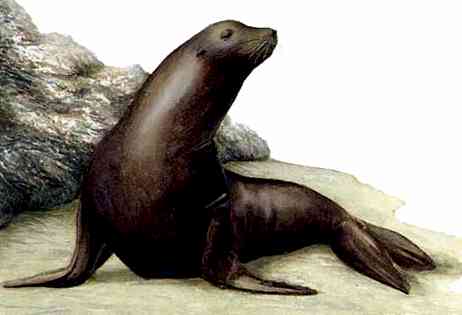 Two California sea lions are making waves in scientific circles and proving that animals DO
think. Rio, a California sea lion, swims around the training pool like an anxious athlete before a race. She’s preparing for her starring role in an experiment designed to
test her ability to think. Eager to start, she voices her impatience with a call that sounds like a cross between a lion’s roar and the croak of a toad.
Two California sea lions are making waves in scientific circles and proving that animals DO
think. Rio, a California sea lion, swims around the training pool like an anxious athlete before a race. She’s preparing for her starring role in an experiment designed to
test her ability to think. Eager to start, she voices her impatience with a call that sounds like a cross between a lion’s roar and the croak of a toad.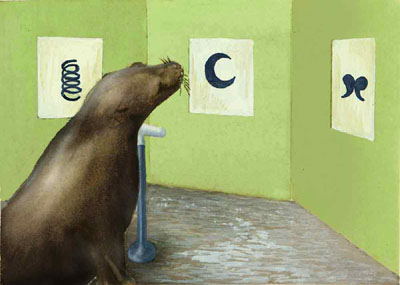 One of the volunteers calls to Rio. She leaps out of the water and gracefully slides to a
stop in front of a wooden poolside screen that looks a little like the set of a tv game show. She rests her head on a stand facing three windows. The center window opens to
reveal a square card, a little more than a foot tall, with a black and white picture of a ship’s anchor on it. Rio studies the picture for a few seconds before the side windows
open, exposing pictures of a cactus on the left and a howling wolf on the right. Rio quickly looks back and forth at the symbols and then waits. Spillman hits a note on the
keyboard to cue Rio, who immediately touches her nose to the picture of the wolf. Spillman hits a higher note signifying a correct answer, and Rio catches a fish that a volunteer
flings from behind the screen. Apparently, everyone agrees that the wolf is somehow related to the anchor.
One of the volunteers calls to Rio. She leaps out of the water and gracefully slides to a
stop in front of a wooden poolside screen that looks a little like the set of a tv game show. She rests her head on a stand facing three windows. The center window opens to
reveal a square card, a little more than a foot tall, with a black and white picture of a ship’s anchor on it. Rio studies the picture for a few seconds before the side windows
open, exposing pictures of a cactus on the left and a howling wolf on the right. Rio quickly looks back and forth at the symbols and then waits. Spillman hits a note on the
keyboard to cue Rio, who immediately touches her nose to the picture of the wolf. Spillman hits a higher note signifying a correct answer, and Rio catches a fish that a volunteer
flings from behind the screen. Apparently, everyone agrees that the wolf is somehow related to the anchor.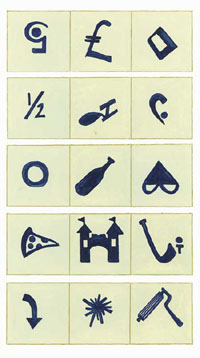 Schusterman’s quest took him to the field of child psychology. He modified methods used to
elicit language comprehension in retarded children and developed techniques to achieve the same results with sea lions. For years, he has rigorously taught Rocky and Rio the skills
and information they need to succeed. The sea lions learned to match many pairs of symbols through trial and error, with fish as positive reinforcement. Once they had a firm
grasp of the relationships between the pairs, the animals were given new choices that had not been directly trained to see how they would react. For example, they had previously
learned that the picture of a castle goes with the golf club, and that the golf club goes with the pizza. But could they make the logical connection that the pizza goes with the
castle?
Schusterman’s quest took him to the field of child psychology. He modified methods used to
elicit language comprehension in retarded children and developed techniques to achieve the same results with sea lions. For years, he has rigorously taught Rocky and Rio the skills
and information they need to succeed. The sea lions learned to match many pairs of symbols through trial and error, with fish as positive reinforcement. Once they had a firm
grasp of the relationships between the pairs, the animals were given new choices that had not been directly trained to see how they would react. For example, they had previously
learned that the picture of a castle goes with the golf club, and that the golf club goes with the pizza. But could they make the logical connection that the pizza goes with the
castle?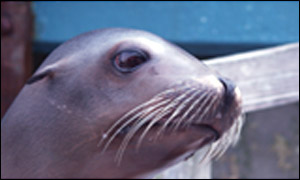 According to researchers at a Californian laboratory, sea lions are very logical
thinkers. A decade after initial studies, the long-term memory of a sea lion called Rio has been tested to the limit. By matching identical shapes and symbols, researchers
have assessed how the animal adapts to learning the concept of sameness.
According to researchers at a Californian laboratory, sea lions are very logical
thinkers. A decade after initial studies, the long-term memory of a sea lion called Rio has been tested to the limit. By matching identical shapes and symbols, researchers
have assessed how the animal adapts to learning the concept of sameness.